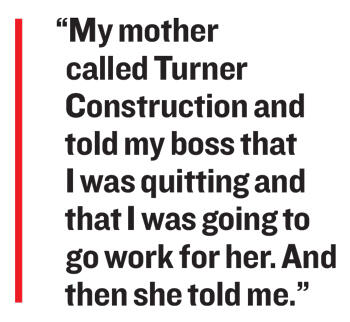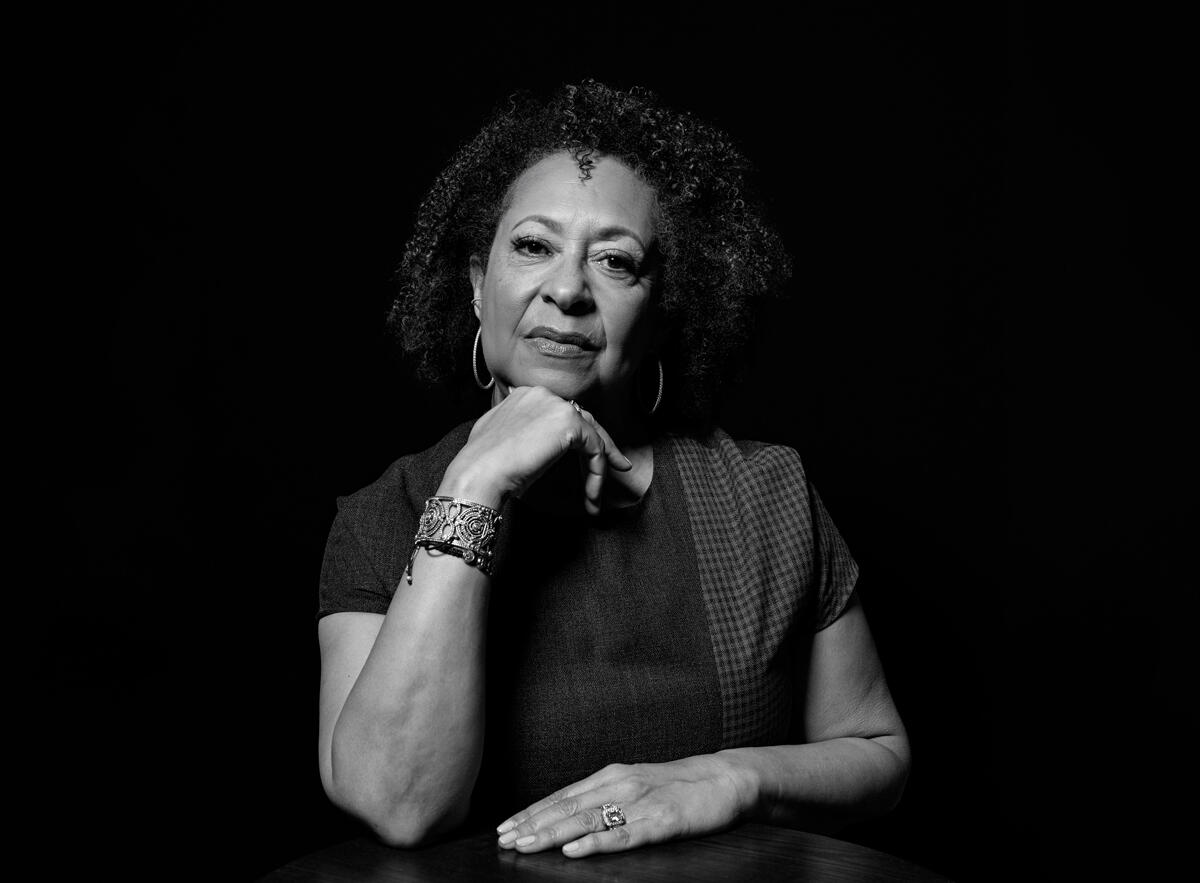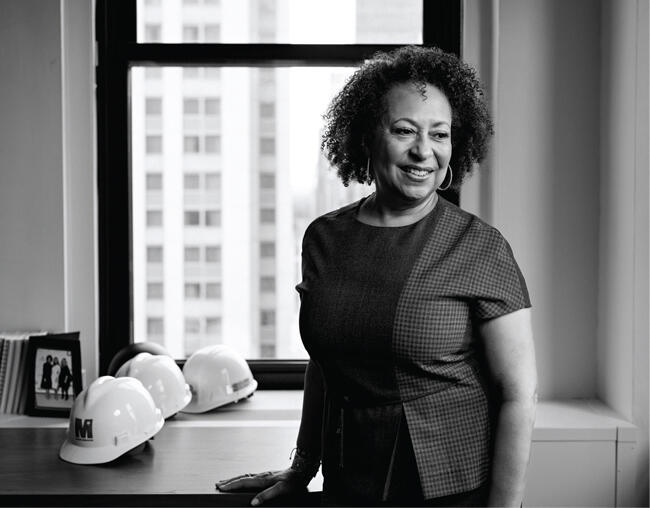An ambitious engineer leaves behind her family’s well-established construction business in Nashville to start anew in the cutthroat world of New York City real estate.
A version of this succession story will play out in the upcoming Paramount+ series “Construction,” which will center on a fifth-generation, Black and female construction leader in the city. The show is inspired by Cheryl McKissack Daniel, CEO of McKissack & McKissack, a construction and design firm that is working on multibillion-dollar infrastructure projects in New York City and has contracted more than $50 billion worth of work over the past decade.
The firm traces its history back nearly two centuries to Moses McKissack, a formerly enslaved person who built a business making and selling bricks. His grandsons went on to found a construction business, McKissack & McKissack, in Nashville in 1905. While the firm’s foundation was made of brick, family became the mortar.
McKissack Daniel took over the business in 1991 from her mother, who had run it out of Nashville since the 1980s after a stroke forced her husband to step down as CEO. McKissack Daniel’s twin sister, Deryl, runs a separate firm of the same name in Washington, D.C.
The New York-based McKissack & McKissack has worked on several major transit, academic, hospital and aviation projects across the tri-state area, including the Oculus at the World Trade Center transit hub and Moynihan Train Hall at Penn Station. The company also helps projects meet goals for hiring minority- and women-owned businesses, a role it is playing at the redevelopment of JFK’s Terminal One in addition to overseeing the $9.5 billion project, which is being built by AECOM Tishman and developed by a consortium of Carlyle Group, Ferrovial, Earvin “Magic” Johnson’s JLC Infrastructure and Ullico.
In 2000, McKissack Daniel co-founded Legacy Engineers, a consulting firm aimed at promoting Black and other underrepresented minorities in engineering. She also chairs the New York Building Foundation, the charitable arm of the New York Building Congress.
 Born: May 15, 1961
Born: May 15, 1961
Lives in: Lincoln Square and Armonk, New York
Hometown: Nashville, Tennessee
Family: Married, two children, four stepchildren
What were you like as a kid?
I got straight A’s. My mom would make us read a Time magazine after we did our homework, and then we could go outside. We would play kickball, shoot the breeze. I went to a private school that was way across town. My twin sister and I were among the first Black people to go to the school. When we graduated, there were probably seven Black students out of a hundred. But we would come home every day to our community. While we had friends at school, they didn’t really live close to us. So we had two sets of friends.
There’s a stereotype about twins and how they often seek to set themselves apart from each other.
Our mother made us dress alike until we were 12 or 13. You probably won’t remember Dr. Welby, but [the television show “Marcus Welby, M.D.”] had these twins, and he talked about the psychology of making twins dress alike. When my mother heard that, we were able to convince her that we should be able to dress differently because we each have our own style, although there are a lot of things that we like that are similar. One time my sister got off a plane — I hadn’t seen her in months — and we had the exact same pocketbook. But as we got older, you know, we had different interests. We became individuals.
Your father worked in construction. Did he bring the job home with him?
I was surrounded by it growing up. He would come home, Mom would prepare dinner, and we’d sit down as a family. He would often have a napkin, and he’s just sketching, working out a detail, working out a concept. He would take us to construction sites on Saturdays. We started tracing at a very early age. By the time we were 12 or 13, we had traced a full set of documents for a residential building in Nashville. Growing up, we got T-squares and Leroy lettering sets.
Did you always want to leave Nashville?
I didn’t realize that we had racial issues to the degree that we did in Nashville until we were at a birthday party for [civil rights attorney] Avon Williams’ son. We were celebrating inside, and then we came out and there was a huge cross burning in their yard. And their yard was small. But as a little child, the cross looked like it was monumental. And then I remember the riots that took place in the ‘60s when Martin Luther King was killed. We had martial law in Nashville; the tanks would go down our streets.
All these things, you focus on for a short amount of time but you forget that they make you up, that they’re part of your experience. And so deep inside, I always wanted to get away from Nashville. My parents brought me to New York when I was 5, and I remember saying, “This is where I’m going to live. I’m going to work in one of those tall buildings.” And that’s exactly what happened. I love New York. You can’t pry me out of this city.
Before you joined your family’s firm, you worked for Turner Construction.
I wanted to be in New York. My first job was with Weidlinger Associates, and I worked for Paul Weidlinger, designing silos for missiles. But then it was just so difficult to live off of, what, $20,000? I started looking around to see where I could make more money, and that was in construction. So after working at Turner for a couple years, my mother called and told my boss that I was quitting and that I was going to go work for her. And then she told me.
How did you react?
“What? You did what? I like my job, Mom. I don’t want to come to Nashville.” But she said she really needed the help. My father had had a stroke, and she had been running the business probably five or six years. She had a lot of projects, and she wanted me to come help her.
When your mom took over the business, she ended up firing most of the employees and essentially rebuilding the company. What was that like?
Mom is very intuitive and very strong-minded. She felt that was her rightful place as CEO, being a woman. People who didn’t get it, she had a problem with. And so she fired them, or she would tell them exactly what she was thinking.
I remember our bank was First American, and I remember she accosted the president of the bank in his lobby and was just like, “You are going treat me the way you treated my husband. You’re going to give me a loan. It’s the same company. We even have more work.” I don’t think watching her do this created any fear for me, because I always felt like she knew what she was doing, and she was just doing it as a female.
It was a different time where people just didn’t get it. They were seeing it for the first time, a woman running a business. The city of Nashville blackballed Mom for about five years because she sued the airport because they did not give a contract to any minority firms. And that was hard for her, but she stood up for what was right. I think my tactics are a little different.
In what way?
I’m not as direct and open. I have more one-on-ones. I move behind the scenes, whereas she’d take on the whole city of Nashville. I don’t do that. I don’t protest contracts. I will voice, “This wasn’t fair.” But I’m not going to protest the New York City School Construction Authority contract or the DASNY contract, because there’s just too much work in New York.
How did you end up focusing on infrastructure and government work?
I think it’s around [minority- and women-owned business enterprise] programs. When I first started the firm here in New York, my plan was to work with other firms that provided the same service as I do, but as their subcontractor. And the only way that I could become their sub was that they worked on government projects that had M/WBE programs. So they would need me as much as I needed them. I’d take 15 percent of the project and do 15 percent of the work. And then as those goals began to grow, and we began to understand how to actually work in a complicated market, we were able to win prime contracts.
What’s it been like working with major developers?
We don’t work with a lot of private developers in the city. I just answered your question with that answer because we don’t get the opportunities to build Hudson Yards. Recently, we’ve started working with JPMorgan Chase, building out some of their branches. All of this is around the awareness of George Floyd and an effort to be inclusive. We’ve had the Googles, the Amazons and Microsofts, interest and conversations with all of these types of companies, but it’s been in the last two years.
McKissack & McKissack is serving as the project manager for the redevelopment of JFK’s Terminal One. What does that role entail?
We manage the design and construction process from beginning to end. For the last three years, it’s been managing how to pull the deal together and make it work. Bringing all those pieces together, it can be a lot of misfits, and getting the contractor to give a good, lean number as opposed to covering their risk. They don’t have all the details. They’re working off conceptuals, and so as the detail comes, it could be more expensive.
Now, we’re working to make sure the design is in accordance with what’s been promised to the Port Authority, and that it’s going to be a world-class airport, and it is beautiful. A major component of this is M/WBE and service-disabled veterans. We have a 30 percent goal in every phase of the project. That’s a big goal. It’s a $9.5 billion development, $3 billion potentially going to M/WBEs and service-disabled veterans.
There have been a number of changes to the city’s M/WBE construction contracting rules. Where do you think these efforts continue to fall short?
There has to be the goal first. Then there has to be prime opportunities. Let’s take Terminal One, where [Loop Capital CEO] Jim Reynolds and “Magic” Johnson are investors. They’re sitting at the highest level of the project saying we want M/WBE, and they bring in a McKissack & McKissack, and then [we] bring in Legacy Engineers, or other M/WBE architectural firms and engineering firms. It’s like an ecosystem that can occur when you start at the very top. If we have M/WBEs slotted there, then it trickles down. People of color tend to hire people of color, not only the businesses, but people. Also, the onus should not always be completely on government. We’ve got to get private industry 100 percent engaged.
What’s the moment that you’re most proud of in your career?
I am proud to be chair of the New York Building Foundation. I feel that that gave me a nod from my peers to say, “We need your leadership. We need your help to build for the future of New York.”
The state rescinded its request for proposals for a development site near the Javits Center, where your firm and the Peebles Corporation had planned an office and hotel tower, largely funded and built by Black-owned companies. What was your reaction to the state’s decision?
I believe that Affirmation Tower is what New York needs right now. It will serve as an icon for New York to say that we are open for business for everyone. It’s about Black people or BIPOC people excellence. Affirmation Tower is the absolute cream of the crop when it comes to new structures. I don’t see affordable housing in that location. Why can’t we build affordable housing where people really want to live? No one, I don’t think, would want to live next to a convention center.
I am disappointed that the RFP has been canceled, and I hope that they are really considering the community around this area. We hope that [the state] will get it together quick, and get the RFP up soon so that we can continue to pursue this project. We are going to go after this with all that we have.


